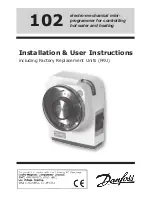
Description of Operation
Chapter 4
4-19
The three-phase relationship between the reference signal and the timing
wave provide a PWM wave to the power transistor base drive. This base
drive switches the power transistors across the 300V DC bus, providing
current to the motor windings, thus causing the motor to turn. A resolver
attached to the motor provides a signal corresponding to the actual rotor
position of the motor. This signal is decoded to a signal representing rotor
position and is fed to the commutation logic along with the torque
command. In this way, the controller combines the desired position signal
and current reference with the decoded resolver signal to produce a
reference signal commanding the controller to speed up or slow down. See
Figure 4.2.
Figure 4.2
Operation
Commutation
Logic &
Current Loop
Integrator
PWM
Generator &
Base Drive
Position
Decoder
Motor
Resolve
r
Current
Referenc
e
Timing
Signal
Generator
Shunt Regulator Operation
The 1391B-ES shunt regulator provides power dissipation for regenerative
conditions when the energy returned to the controller by the motor exceeds
that which can be stored in the bus capacitors. The shunt regulator
monitors the bus voltage and at a predetermined “ON” point activates the
shunt regulator transistor, allowing current to flow through the shunt
resistor and dissipating power in the form of heat. A fuse is placed in series
with the resistor to protect it against short circuit conditions. When the
shunt transistor is activated and power is being dissipated at the resistor,
the bus voltage will quickly decrease, turning the transistor off when the
voltage reaches the “OFF” point. This cycle repeats, provided the bus
voltage continues to increase to the “ON” point. If too much regenerative
energy is present, the bus voltage will continue to increase even with the
shunt regulator on. At a predetermined bus voltage level, the 1391B-ES
will determine that an overvoltage condition exists, and trip out on an
Overvoltage Fault.
Summary of Contents for 1391B Series
Page 8: ...Introduction Chapter 1 1 6 End of Chapter...
Page 19: ...Receiving Unpacking and Inspection Chapter 3 3 17 End of Chapter...
Page 27: ...Description of Operation Chapter 4 4 25 End of Chapter...
Page 55: ...The 1326 AC Servomotor Chapter 8 8 57 End of Chapter...
Page 63: ...Transformers and Shunt Regulators Chapter 9 9 61 End of Chapter...
Page 71: ...Troubleshooting Chapter 10 10 69 End of Chapter...
Page 80: ...Cable Information Appendix C C 78 End of Appendix...
Page 82: ...Controller Options Appendix D D 80 End of Appendix...
















































